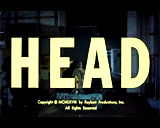
|
Filmsite's Greatest Films
|

|
Head (1968) In co-writer/co-producer/director Bob Rafelson's satirical musical comedy-fantasy - the script was co-written by Rafelson (his debut film) with his mostly-unknown co-producer Jack Nicholson; the trippy movie was designed to showcase the crazy antics of the wildly-popular singing group The Monkees - it was their motion-picture debut film. The disjointed, weird, stream-of-consciousness 86-minute film featured spoofs of various genre-related vignettes (i.e., western, desert saga, war film, musical, horror film, and science-fiction) and unrelated set pieces to display the fun-loving frolicking group of four singing stars - Micky Dolenz, lead singer Davy Jones, Peter Tork, and Michael Nesmith. Its guest stars included Victor Mature (as The Big Victor), Annette Funicello (as Minnie, Davy's fantasy girlfriend), boxer Sonny Liston as an Extra, Frank Zappa as 'The Critic,' Tor Johnson (as a Security Guard), SF stripper Carol Doda (as Sally Silicone) and Timothy Carey (as the terrorizing Lord High 'n Low). It also included footage of Monkee concerts, Vietnam War atrocities (the shot to the head), and clips of film classics (Bela Lugosi in the Poe horror classic The Black Cat (1934), the boxing drama Golden Boy (1939), Rita Hayworth in Gilda (1946), and Charles Laughton as Roman King Herod in Salome (1953), amongst others). One of the best one-liners in the film was delivered by Teri Garr (as Testy True) to Mike after a rattlesnake bit her finger: "Suck it, before the venom reaches my heart!" Originally in 1965, Rafelson had been mass-marketing and promoting the group, just as the British pop invasion was taking hold and the Beatles' released director Richard Lester's 'day-in-the-life' musical film A Hard Day's Night (1964), followed by Head's predecessor and Lester's adventure-comedy sequel Help! (1965). However, by the time the film was released, the pop group was in a downward spiral following the cancellation of their NBC TV show (that ran from 1965-1968 with 59 episodes, cancelled after two seasons). The Monkees were known at first for being a manufactured pop entity, and inauthentically and dishonestly didn't even play their own instruments. They even mocked their own condition, singing in unison: "Hey, hey, we are The Monkees, to that we all agree. A manufactured image with no philosophies." Some claimed that the free-form film was a deliberate move on the part of its producers to sabotage and deconstruct the singing group now that Monkeemania was dead, and to provide it was a 'swan song.' It was released in the same year as more thought-provoking films for the public, including Kubrick's 2001: A Space Odyssey (1968) and Planet of the Apes (1968). The non-sensical and irreverent film, originally rated G, was budgeted at $750,000 (although other sources claimed between $1-2 million), and ended up being both a critical failure and a box-office flop. It received very mixed reviews, and was mostly criticized for its daffy and zany antics of the 'no-talent' group of actors. The music performers were portrayed as synthetic, pre-programmed actors (or puppets) destined to follow a set script without any free-will to speak their own lines or to act the way that they wanted. By this time, the burgeoning counter-cultural attitudes of many teenybopper filmgoers rejected the carefully pre-set public image that they perceived was behind the corporate, Hollywood-marketed phenomenon of the Monkees ("The Pre-Fab Four"), and adult audiences were also put off or disinterested. Later, the film developed a 'midnight movie' cult following after CBS-TV broadcasts of the film in the mid-1970s, and cable-TV showings in the 1980s.
|
Greatest Scenes: Intro | What Makes a Great Scene? | Scenes: Quiz Scenes: Film Titles A - H | Scenes: Film Titles I - R | Scenes: Film Titles S - Z |